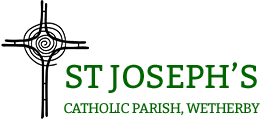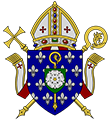History of the Church
Until the middle of the 19th Century, there was no Catholic diocesan structure and, in the absence of parishes with resident priests, Catholics were welcomed into the home of local Catholic gentry to attend Mass. In Wetherby, this meant attending services in the Chapel of Stockeld Park, the home of Peter Middleton. In 1850, when Peter Middleton decided to move to his property in Ilkley, this arrangement could not continue so he built the Church of Mary Immaculate in Sicklinghall. He brought the French missionary order, The Oblates of Mary Immaculate (OMI) to minister to the faithful here.
With the growing importance of Wetherby as a market town, the OMI established the parish here in 1876 and the Church of St Joseph (now the Chuch Hall) was built in 1882. In 1990 after 160 years service, the OMI left the parish and it became the responsibility of the Diocese of Leeds.
The present Church of St Joseph was designed by the well-known Architect, Mr. Vincent Stienlet, and was opened in 1986. The art work is by the internationally known artist Fenwick Lawson and its symbolic arrangement is focussed on the sculpture of Christ ascending from the cross with his gaze and arm stretched outwards to the world. The church won the Leeds Award for Architecture in 1987.
You will find St Joseph’s open from morning mass until 3.00pm Tuesday to Friday, until 7pm Saturday and until Noon on Sunday. It is a light-filled and well worth a visit – please sign our visitors’ book at the back of the church. Meanwhile, the Blessed Sacrament is still reserved in The Church of the Immaculate Conception in Sicklinghall, and it is open for private prayer daily; Mass is celebrated there on a monthly basis. Appropriately, Peter Middleton, the benefactor of the Church, is buried below the Lady Altar with his wife, Juliana.

